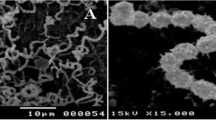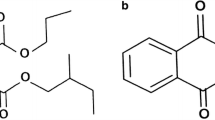Abstract
The present work deals with isolation of Streptomyces associated with marine sponges and its bioactive potential. Streptomyces sp. were isolated from the marine sponges Callyspongia diffusa, Mycale mytilorum, Tedania anhelans and Dysidea fragilis. From the initial screening, 94 cultures of Streptomyces were obtained and from these 58 cultures exhibited antagonism against bacteria, 36 strains against fungi and 27 strains exhibited broad spectrum activity against both. The submerged culture extracts of the 58 anti-bacterial isolates were analysed and of these 58 strains, 37 strains showed positive inhibition against Bacillus subtilis, 43 against Staphylococcus aureus, 10 against Vibrio cholerae and 10 against Escherichia coli. The antifungal activities of the 36 strains were also evaluated and 27 strains showed positive inhibition against Aspergillus niger, 23 against Saccharomyces cerevisiae and 16 against Candida albicans. The production of polyene substances from the active extracts was confirmed by UV spectral analysis by the absorbance peaks that ranged from 225 to 262 nm and the TLC (R f values) ranging from 0.40 to 0.78. The results indicate that Streptomyces strains isolated from marine sponges produce potential antibacterial, antifungal and broad spectrum antibiotic compounds.



Similar content being viewed by others
References
Annandale N (1914) Fauna symbiotica indica. Some sponges commonly associated with oysters and mussels in Madras Harbour and the Chilka Lake. Rec Indian Mus 10(VII):149–158
Atta HM, Ahmad MS (2009) Antimycin-A antibiotic biosynthesis produced by Streptomyces Sp. AZ-AR-262: taxonomy, fermentation, purification and biological activities. Aust J Basic Appl Sci 3(1):126–135
Dharmaraj S, Ashokkumar B, Dhevendaran K (2009) Food-grade pigments from Streptomyces sp. isolated from the marine sponge Callyspongia diffusa. Food Res Int 42:487–492
Dhevendaran K, Annie Mathew K (1999) Antibiotic and l-asparaginase activity of Streptomyces isolated from fish, shell fish and sediment of Veli estuarine Lake along the Kerala coast. Indian J Mar Sci 28:335–337
Ellaiah P, Ramana T, Bapi Raju K, Sujatha P, Uma Sankar A (2004) Investigation on marine actinomycetes from Bay of Bengal near Kakinada coast of Andhra Pradesh. Asian J Microbiol Biotech Environ Sci 6:53–56
Faulkner DJ (2002) Marine natural products. Nat Prod Rep 19:1–48
Faulkner DJ, Harper MK, Salomon CE, Schmidt EW (1999) Localization of bioactive metabolites in marine sponges. Mem Queensl Mus 44:167–173
Faulkner DJ, Harper MK, Haygood MG, Salomon CE, Schmidt EW (2000) Symbiotic bacteria in sponges: sources of bioactive substances. In: Fusetani N (ed) Drugs from the sea. Karger, Basel, pp 107–119
Gandhimathi R, Arunkumar M, Selvin J, Thangavelu T, Sivaramakrishnan S, Kiran GS, Shanmughapriya S, Natarajaseenivasan K (2008) Antimicrobial potential of sponge associated marine Actinobacteria. J Mycol Med 18:16–22
Goodfellow M, O’Donnell AG (1989) Roots of bacterial systematic. In: The handbook of new bacterial systematic. Academic Press, London, pp 3–54
Hentschel U, Hopke J, Horn M, Friedrich AB, Wagner M, Hacker J, Moore BS (2002) Molecular evidence for a uniform microbial community in sponges from different oceans. Appl Environ Microbiol 68:4431–4440
Hentschel U, Usher KM, Taylor MW (2006) Marine sponges as microbial fermenters. FEMS Microbiol Ecol 55:167–177
Hill M, Hill A, Lopez N, Harriott O (2006) Sponge-specific bacterial symbionts in the Caribbean sponge, Chondrilla nucula (Demospongiae, Chondrosida). Mar Biol 148:1221–1230
Hoffmann F, Larsen O, Thiel V, Rapp HT, Pape T, Michaelis W, Reitner J (2005) An anaerobic world in sponges. J Geo Microbiol 22:1–10
Hooper JNA (2000) ‘Sponguide’ guide to sponge collection and identification version. Queensland museum, Australia
Hooper JNA, Van Soest RWM (2002) Systema Porifera: a guide to the classification of sponges. Kluwer Academic/Plenum Publishers, New York
Hwang BK, Ahn SJ, Moon SS (1994) Production, purification and antifungal activity of the antibiotic nucleoside, tubericidine, produced by Streptomyces violaceoniger. Can J Bot 72:480–485
Ilic SB, Konstantinovic SS, Todorovic ZB (2005) UV/Vis analysis and antimicrobial activity of Streptomyces isolates. Medi Biol 12:44–46
Imhoff JF, Stöhr R (2003) Sponge-associated bacteria. In: Müller WEG (ed) Marine molecular biotechnology. Springer–Verlag, New York, pp 35–56
Kobayashi M (2000) Search for biologically active substances from marine sponges. In: Fusetani N (ed) Drugs from the sea. Karger, Basel, pp 46–58
Lee YK, Lee JH, Lee HK (2001) Microbial symbiosis in marine sponges. J Microbiol 39:254–264
Li F, Maskev RP, Qin S, Sattler I, Fiebig HH, Maier A, Zeeck A, Laatsch H (2005) Chinikomycins A and B: isolation, structure elucidation and biological activity of novel antibiotics from a marine Streptomyces sp. isolated M045. J Nat Prod 68:349–353
Lieberkühn N (1859) Neue Beiträge zur Anatomie der Spongien. Archiv für Anatomie und Physiologie, pls IX–XI 30(3): 353–382, 515–529
Locci R (1989) Streptomycetes and related genera. In: Williams ST, Sharpe ME, Holt JG (eds) Bergey’s manual of systematic bacteriology. Williams and Wilkins, Baltimore, pp 2451–2493
Lombo F, Velasco A, de la Calle F, Brana AF, Sanchez-Pulles JM, Mendez C, Salas JA (2006) Deciphering the biosynthesis of the antitumor thiocoraline from a marine actinomycete and its expression in two Streptomyces species. Chembiochem 7:366–376
Madigan MT, Martiko JM, Parker J (1997) Antibiotics: isolation and characterization. In: Brock biology of microorganisms, 8th edn. Prentice-Hall International Inc., New Jersey, pp 440–442
Maskey RP, Helmke E, Fiebig HH, Laatsch H (2002) Parimycin: isolation and structure elucidation of a novel cytotoxic 2,3-dihydroquinizarin analogue of gamma-indomycinone from a marine streptomycete isolate. J Antibiot 55:1031–1035
Maskey RP, Helmke E, Laastsch H (2003) Himalomycin A and B: isolation and structure elucidation of new fridamycin type antibiotics from a marine Streptomyces isolate. J Antibiot 56:942–949
Meiying Z, Zhicheng Z (1998) Identification of marine actinomycetes S-216 strain and its biosynthetic conditions of antifungal antibiotic. J Xiamen Univ Nat Sci 37:109–114
Montagu G (1818) An essay on sponges, with descriptions of all the species that have been discovered on the coast of Great Britain. Mem Werner Nat Hist Soc pls III–XVI 2 (1): 67–122
Montalvo NF, Mohamed NM, Enticknap JJ, Hill RT (2005) Novel actinobacteria from marine sponges. Antonie Van Leeuwenhoek 87:29–36
Piel J, Hui D, Wen G, Butzke D, Platzer M, Fusetani N, Matsunaga S (2004) Antitumor polyketide biosynthesis by an uncultivated bacterial symbiont of the marine sponge Theonella swinhoei. Proc Natl Acad Sci USA 101:16222–16227
Prem Anand T, Bhat AW, Shouche YS, Roy U, Siddharth J, Sarma SP (2006) Antimicrobial activity of marine bacteria associated with sponges from the waters off the coast of South East India. Microbiol Res 161:252–262
Pridham TG, Lyons AJ Jr (1961) Streptomyces albus (Rossi Doria) Waksman et al. Henrici: taxonomic study of strains labeled Streptomyces albus. J Bacteriol 81:431–441
Proksch P (1994) Defensive roles for secondary metabolites from marine sponges and sponge-feeding nudibranchs. Toxicon 32:639–655
Ridley SO (1884) Spongiida. Report on the zoological collection made in the Indo-Pacific Ocean during the Voyage of H.M.S. ‘Alert’ 1881-2. British Museum (Natural History), London, pp 366–482, 582–635
Sahin N, Ugur A (2003) Investigation of the antimicrobial activity of some Streptomyces isolates. Turk J Biol 27:79–84
Shirling EB, Gottlieb D (1966) Methods for characterization of Streptomyces sp. Int J Syst Bacteriol 16:313–340
Shomurat T, Yoshida J, Amano S, Kojina M, Niida T (1979) Studies on actinomycetal producing antibiotics only in agar culture. I. Screening taxonomy and morphology—productivity relationship of Streptomyces halstedii, strain SF-1993. J Antibiot 32:427–435
Solanki R, Khanna M, Lal R (2008) Bioactive compounds from marine actinomycetes. Indian J Microbiol 48:410–431
Suja Devan V (1999) Environmental impact assessment. Studies on microbial population of Veli Lake. Indian J Exp Biol 10:46–58
Sujatha P, Raju K, Ramana T (2005) Studies on a new marine streptomycete BT-408 producing polyketide antibiotic SBR-22 effective against methicillin resistant Staphylococcus aureus. Microbiol Res 160:119–126
Swaadoun I, Hameed KM, Moussauui A (1999) Characterization and analysis of antibiotic activity of some aquatic Actinobacteria. Microbios 99:173–179
Takahashi Y, Omura S (2003) Isolation of new actinomycete strains for the screening of new bioactive compounds. J Gen Appl Microbiol 49:141–154
Takaizawa M, Colwell W, Hill RT (1993) Isolation and diversity of actinomycetes in the Chesapeake Bay. Appl Environ Microbiol 59:997–1002
Tanaka Y, Omura O (1990) Metabolisms and products of actinomycetes—an introduction. Actinomycetologica 4:13–14
Taylor MW, Radax R, Steger D, Wagner M (2007) Sponge-associated microorganisms: evolution, ecology, and biotechnological potential. Microbiol Mol Biol Rev 71:295–347
Thacker RW (2005) Impacts of shading on sponge-cyanobacteria symbioses: a comparison between host-specific and generalist associations. Integr Comp Biol 45:369–376
Thakur D, Yadav A, Gogoi BK, Bora TC (2007) Isolation and screening of Streptomyces in soil of protected forest areas from the states of Assam and Tripura, India, for antimicrobial metabolites. J Mycol Med 17:242–249
Thomas PA (1970) On some deep sea sponges from the Gulf of Mannar with descriptions of three new species. J Mar Biol 12:202–209
Webster NS, Hill RT (2001) The culturable microbial community of the Great Barrier Reef sponge Rhopaloeides odorabile is dominated by a α proteobacterium. Mar Biol 138:843–851
Woo JH, Kitamura E, Myouga H, Kamei Y (2002) An antifungal protein from the marine bacterium Streptomyces sp. strain AP77 is specific for Pythium porphyrae, a causative agent of red rot disease in Porphyra spp. Appl Environ Microbiol 68:2666–2675
Zhang H, Zhang W, Jin Y, Jin M, Yu X (2008) A comparative study on the phylogenetic diversity of culturable actinobacteria isolated from five marine sponge species. Antonie Van Leeuwenhoek 93:241–248
Acknowledgments
The authors wish to thank Dr P. A. Thomas, retired scientist, CMFRI, Vizhinjam, Kerala, India for his help in identification of sponges and DST-SERC (SR/S0/AS-57/2004) New Delhi, for financial support.
Author information
Authors and Affiliations
Corresponding author
Rights and permissions
About this article
Cite this article
Dharmaraj, S., Sumantha, A. Bioactive potential of Streptomyces associated with marine sponges. World J Microbiol Biotechnol 25, 1971–1979 (2009). https://doi.org/10.1007/s11274-009-0096-1
Received:
Accepted:
Published:
Issue Date:
DOI: https://doi.org/10.1007/s11274-009-0096-1




